#north american indian
Text

Seven riders on horseback and a dog trek across Canyon de Chelly, Arizona. Photo by Edward S. Curtis, 1904.
Click Links at bottom of pictures to EMBIGGEN
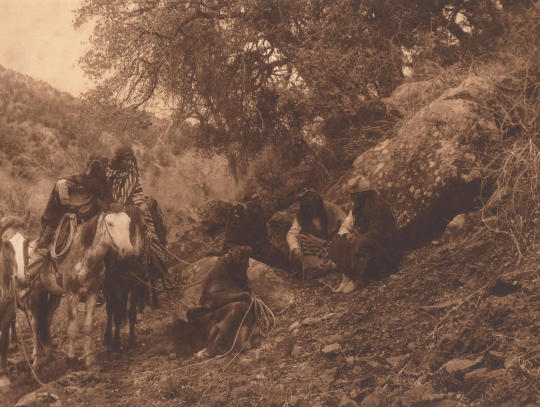
Edward S. Curtis - Story Telling - Apache, 1903

Edward S. Curtis - Navajo Woman and Two Children on Horseback, 1906

Edward S. Curtis - The Canyon, 1904
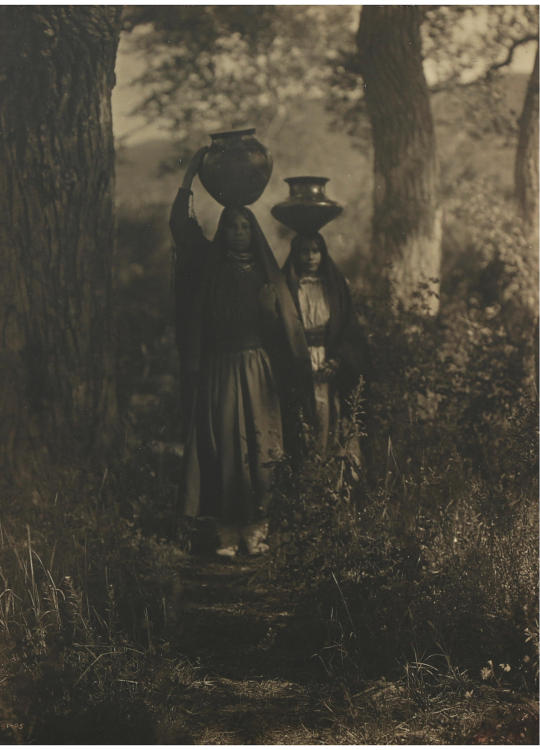
Edward S. Curtis - Taos Water Girls, 1905
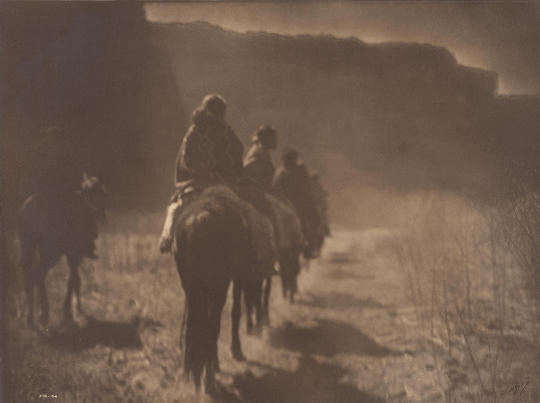
Edward S. Curtis - The Vanishing Race, Navajo, 1904

Geronimo – Apache, 1905 - Edward S. Curtis

Edward S. Curtis ... Tells the Intimate Story of Indian Life with Motion Pictures.... Chicago: The National Printing and Engraving Co., c.1910. - Lithographic poster printed in 1910, when Curtis debuted his "picture opera," The Story of a Vanishing Race. The show included magic lantern slides of the photographer's work painstakingly hand-colored, supplemented by moving pictures, sound recordings of native songs, an orchestra, and Curtis's own narration.

Portrait of Edward S. Curtis, 1907 - by: Adolph Muhr
Edward Sherriff Curtis (February 19, 1868 – October 19, 1952) was an American photographer and ethnologist whose work focused on the American West and on Native American people. Sometimes referred to as the "Shadow Catcher", Curtis traveled the United States to document and record the dwindling ways of life of various native tribes through photographs and audio recordings.
Curtis's goal was to document Native American life, pre-colonization. He wrote in the introduction to his first volume in 1907, "The information that is to be gathered … respecting the mode of life of one of the great races of mankind, must be collected at once or the opportunity will be lost." Curtis made over 10,000 wax cylinder recordings of Native American language and music. He took over 40,000 photographic images of members of over 80 tribes. He recorded tribal lore and history, described traditional foods, housing, garments, recreation, ceremonies, and funeral customs. He wrote biographical sketches of tribal leaders.
#photogravure#edward s. curtis#historical photos#native americans#indigenous#navajo#apache#photagraphy#geronimo#ethnology#edward sherriff curtis#north american indian#the vanishing race
70 notes
·
View notes
Text

Movie # 86 of 2023: Prey
#prey#action#adventure#drama#dan trachtenberg#patrick aison#jim thomas#john thomas#sarah schachner#jeff cutter#claudia castello#angela m. catanzaro#english#french#north american indian#arri alexa mini lf#anamorphic#2022#86#horror#sci fi
0 notes
Link
Just added to the Vintage shop!
~ “The Girl Who Married a Ghost and Other Tales From the North American Indian” (1978)
#The Girl Who Married a Ghost#Tales from the North American Indian#North American Indian#Vintage Etsy#Vintage Books#VintageCDChyld#Vintage#Etsy
0 notes
Photo

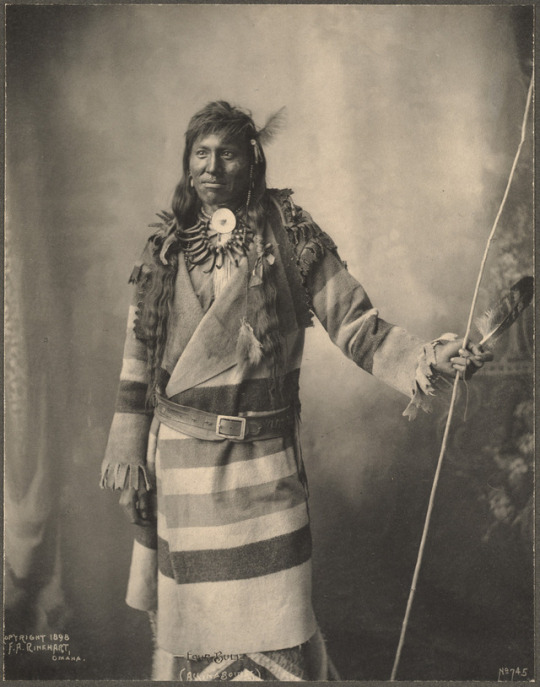

Photographs of men from the Assiniboine tribe;by Frank Rinehart;
Chief Yellow Boy giving a piece sign, 1890-1891
Four Bull and Chief Wets-It, 1898
#native american#the americas#mdpcostume#traditional dress#tribal#North America#north american#american indian#frank rinehart#costume
97 notes
·
View notes
Text
i love!!! pavitr!!!! best part about him is that the astv creators just said he's indian. he could be any type of indian and you wouldn't be wrong. maybe he's malayali. maybe he's from mizo. maybe he's from punjab. maybe he's tamilian. maybe he's from sikkim. you decide!!!!
#'oh but he's from mumbattan!!1!!“'#ok. so?#mumbai based malayali#mumbai based punjabi#mumbai based manipuri kid#he really is mr. india#and like not to be too bitter here but like usually when we get indian characters they're usually north indian#which like i get. there are a lot more north indians in america than south probably but like while there are some overarching similarities#between north and south indians we're not the same. and it does get a little disheartening watching a new indian character#onscreen knowing you can't really relate to them at all.#but like pav is just like ambiguously indian. like he has no identifying characteristics of any indian states#like the most you could say is that he's maharashtrian cause mumbai is in Maharashtra#and like i love pavitr for that!!!#also before someone says smth#disclaimer! evrythg i said in the tags is based on how i feel as an american born south indian kid#pavitr prabhakar#astv#spiderman india
108 notes
·
View notes
Text


North American Indian
#American Indian#North#girl#art#body#digital art#picture#color#pink#nature#fantasy#city#north america
35 notes
·
View notes
Photo

America: Being the Latest, and Most Accurate Description of the New World (1671)
#america#north america#south america#central america#west indies#the new world#1492#aztec empire#inca empire#american indians
71 notes
·
View notes
Text
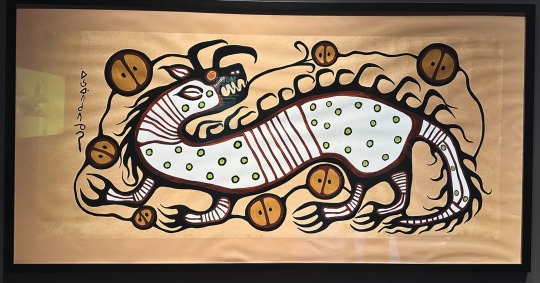
Mishipashoo (Water Spirit) Norval Morriseau 1974, Acrylic on Paper (replica).
#art#indigenous#indigenous art#anishinaabe#spirit#water spirit#Mishipashoo#great lakes#american art#American Indian art#painting#spirit painting#folklore#American legends#North American folklore
17 notes
·
View notes
Text


Legends of the Missouri and Mississippi
Hopewell
1874
#old#books#old bookshop#bibliophile#old books#antiquarian bookshop#michaelmoonsbookshop#vintage#whitehaven#antique#american indians#native american#legends#folklore#North American Indians#missouri#mississippi#findingnewhomesforloldbookssince1970
15 notes
·
View notes
Text

The Indian Runner (1991), dir. Sean Penn IMDB
#The Indian Runner#Sean Penn#mise en scene#cinematography#cinema#Viggo Mortensen#USA#1990s#film#one perfect shot#north american cinema#us cinema#classicfilmedit#filmedit
17 notes
·
View notes
Text

Edward S. Curtis - The North American Indian , Portfolios 1-20; and Volumes 1-20

Edward S. Curtis - Chief Joseph - 1908
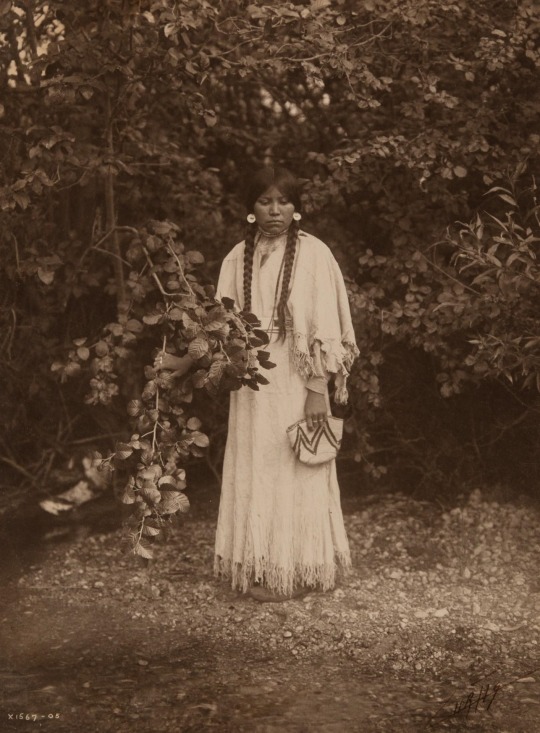
Edward S. Curtis - Nespilim Girl, 1905

Edward S. Curtis - Okúwa-Tse ("Cloud Yellow")-San Ildefonso 1905

Edward S. Curtis - Badlands - 1905

Edward S. Curtis - A Zuñi Girl - 1905

Edward S. Curtis - Piopio-Maksmaks, Profile - Walla Walla - 1905

Edward S. Curtis - Saguaro Fruit Gatherers - Maricopa - 1906

Edward S. Curtis - Otter Robe - Atsina - 1905

Edward S. Curtis - The Piki Maker - Walpi - 1904
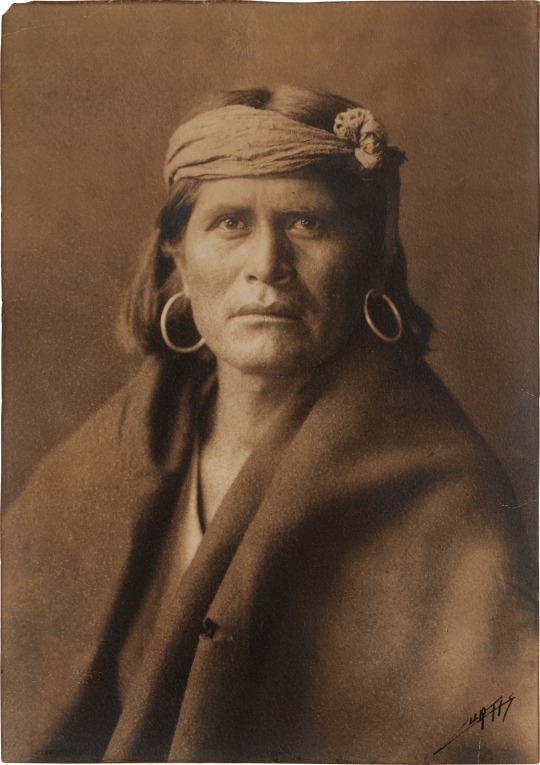
Edward S. Curtis - A Walpi Man - 1903

Edward S. Curtis - An Apache Baby

Edward S. Curtis - Two Oglala Girls on Horseback - 1907
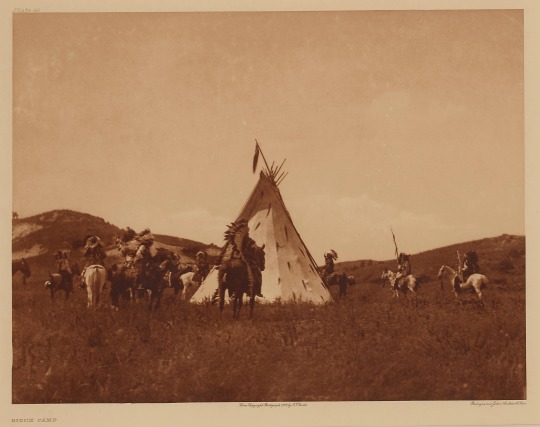
Edward S. Curtis - Sioux Camp - 1907

Edward S. Curtis - The Maid of Dreams - 1907
#indigenous#native american#american indian#historic photographs#photography#photographers#edward s. curtis#books#North American Indian
10 notes
·
View notes
Photo

Bandoleer Bag. Fox artist, c. 1890. Cloth and beads.
Small rectangular cloth bag with long cloth handle. Completely beaded, with multi-colored angle patterns repeating on white beaded background, the field is organized in “threes.” Ribbonwork edging, and beaded and yarn tassels on bottom. The direct influence of Plains is visible in the bolder design of this bag.
#Bandoleer Bag#native american art#beading#Art of the Great Lakes Indians#Fox artist#native north american artifacts
3 notes
·
View notes
Text

Books
3 notes
·
View notes
Text
US Swifties: I DIDN'T GET TICKETS TO THE ERAS TOUR- I FEEL SO UNLUCKY 😭😭😭
International Swfities with Tour Dates: US SWIFTIES NEED TO STOP BUYING TICKETS HERE! LET US HAVE OUR MOMENT!! IT'S THE FIRST TIME SHE'S TOURING HERE!!!!
indian swifties: yeah, we exist...
#what was seven about?#i really thought she'd reserve one tour date here#north american swfities also get to see the concert film first#taylor swift#taylors version#swifties#taylor nation#the eras tour#taylor swift debut#fearless tv#speak now tv#red tv#1989 tv#reputation tv#lover#folklore#evermore#midnights#indian swiftie#india#we'll move to india forever?!?#august
13 notes
·
View notes
Text
planning out a canon-complicit tgcf fic is so hard not only bc I have to be even stricter with remaining in-character and faithful to lore but also the physical setting itself. for example. ahem:
DID THEY HAVE BANANAS IN THE CENTRAL PLAINS?
LOOK AT--NO LOOK AT ME. LOOK IN MY EYES. WOULD ANYONE IN TGCF KNOW WHAT A BANANA IS. LOOK AT ME-
#hewwo#NOW. i do i have some non-exhaustive research into the HISTORICAL conditions of fruit in china during the different real life dynasties#for example. watermelon only showed up in ''china'' around 10th century onwards. before that it was mostly in the indian subcontinent#but what about bananas. what about other tropical fruits from farther south#DO THEY KNOW OF THE HUMBLE ATIS. THE DURIAN. THE LANGKA. THE ARATILIS#unfortunately they definitely won't have manchineels (north/south american fruit) so i can't use that. much as i wish to 🙄
10 notes
·
View notes
Text
And now that you've answered that, why not sit back and enjoy a brief history of the American Revolution:
First, the Seven Years War happens. It's mostly thought of as having been fought in Europe, but a campaign (not that kind) is also fought in North America. It is called "The French and Indian War" by the locals.
Britain wins the war against France, and subsequently gets the rights to all land east of the Mississippi river.
Colonialists start moving onto native land, probably with a lot of aggression and arrogance. This is ok so far as Britain is concerned, because they assume that the colonialists can play nice with the natives.
That is not the case. As such, the natives push back against them. 500+ colonialists die during this conflict.
Britain realizes that the colonialists CAN'T play nice and forbids them from going west of Appalachian mountains. Troops are sent to enforce this. Taxes are raised to support the troops, levied mostly on the colonies because they're the reason this mess exists at all.
Wealthy Land / Business Owners get frustrated by Britain imposing its will on the colonies and disallowing them from spreading West. Sure, taxes are bad, but it probably wasn't the little folks paying the lion's share of them, except insofar as the fees associated with them are concerned, but you pay sales taxes, so you know that heavy toll already.
Unhappy working class colonialists don't like paying those extra fees, like any USAmerican doesn't like, but this dislike is further stoked into unhappiness via propaganda until war is inevitable.
France, convinced by wealthy colonialists, backs to revolution as a "fuck you" to Britain ("We can't have land in the Americas? Fine. You don't get your precious colonies, either")
America is born! If you're a wealthy white man you're free to do whatever! Otherwise you can fuck off.
Imperialist conquest of the continent begins in earnest ("but really it's just our Manifest Destiny to control the whole continent so it's alright").
+++++
Ultimately, if they don't benefit the wealthy, any establishment of rights in USAmerica regarding a disenfranchised group only happens after massive civil disruption.
Said rights are never seen as good by the establishment, only as the necessary price for keeping/restoring the peace.
For Example:
The north fought the civil war to keep the south in the union. The south fought the civil war to keep their slaves.
If Lincoln hadn't been killed and his VP hadn't bungled things as much as he did, there would be no amendment regarding slavery, it would be a purely legislative matter, not a constitutional one.
This means that, if Lincoln lived, we'd need to worry about republicans overturning anti-slavery laws too, in addition to everything else.
#american revolution#America#usa#founding fathers#Tax the rich#eat the fucking rich#eat the rich#manifest destiny#the big lie#imperialism#colonialism#westward expansion#north america#seven years war#french and indian war#thirteen colonies#original colonies#taylor polls
3 notes
·
View notes